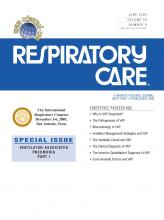Abstract
Hospital-associated pneumonia (HAP) is one of the most common infections acquired among hospitalized patients. HAP is associated with excess mortality and increased medical care costs. The rise in HAP due to antibiotic-resistant bacteria has resulted in more common administration of inappropriate antimicrobial treatment, with an associated increased risk of hospital mortality. Ventilator-associated pneumonia (VAP) refers to HAP occurring in patients requiring mechanical ventilation. VAP is the most common nosocomial infection among patients with acute respiratory failure. Physicians treating patients with HAP and VAP should be aware of the predominant local pathogens associated with these infections and their antimicrobial susceptibility patterns. This will allow more appropriate initial antibiotic selection in order to optimize treatment regimens and clinical outcomes. Additionally, clinical strategies aimed at the prevention of HAP and VAP should be employed in all hospital settings caring for patients at risk for these infections.
Footnotes
- Correspondence: Marin H Kollef MD, Washington University School of Medicine, Campus Box 8052, 660 South Euclid Avenue, St Louis MO 63110. E-mail: mkollef{at}im.wustl.edu.
- Copyright © 2005 by Daedalus Enterprises Inc.







